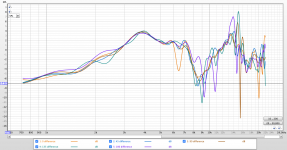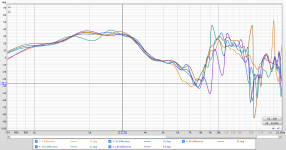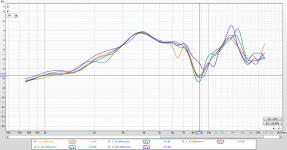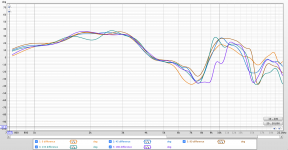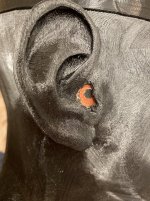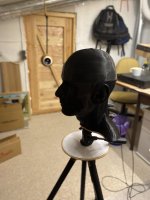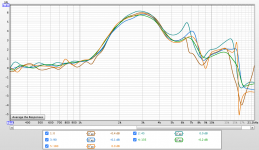Good stuff, Baffless. 
This paper states that according to the author there is independence from sound direction up to about 10 kHz, but if you look at the graphs I don't understand how they could have come to that conclusion. I think they used an arbitrary threshold that is far too generous. Maybe they're not mixing engineers
If you look at the scale, you can see variations of 2-5 dB in the 2-6 kHz range for the 3 transfer functions (sec II A). This is an EQ that would be quite audible.
Between the 12mm inside measurement and the entrance measurement there is about 10 dB difference between the 3 transfer functions at around 6 kHz. While it is true that it is a narrow peak, I don't see how one with some mixing experience could consider that a minor detail.
But not only that, the study completely disregards the phase response (maybe because it's a quarter of a century old, maybe because of the false belief that phase is somewhat not influential).
Phase response is actually very important for transients (and most sounds, even in music, are very transient in nature), so if you intend to do some serious measurements, depending on your testing equipment, it would be great if you investigated that side of the transfer functions as well.

This paper states that according to the author there is independence from sound direction up to about 10 kHz, but if you look at the graphs I don't understand how they could have come to that conclusion. I think they used an arbitrary threshold that is far too generous. Maybe they're not mixing engineers
If you look at the scale, you can see variations of 2-5 dB in the 2-6 kHz range for the 3 transfer functions (sec II A). This is an EQ that would be quite audible.
Between the 12mm inside measurement and the entrance measurement there is about 10 dB difference between the 3 transfer functions at around 6 kHz. While it is true that it is a narrow peak, I don't see how one with some mixing experience could consider that a minor detail.
But not only that, the study completely disregards the phase response (maybe because it's a quarter of a century old, maybe because of the false belief that phase is somewhat not influential).
Phase response is actually very important for transients (and most sounds, even in music, are very transient in nature), so if you intend to do some serious measurements, depending on your testing equipment, it would be great if you investigated that side of the transfer functions as well.
Last edited:
Hi,
Here are some measurements. Pictures with first reflections gated out after 1.4ms.Anyway i don't need low frequencies.So i could do test at my small workshop. Two unsmoothed and two 1/6 oct smoothed. Did special loudspeaker for testing.Small with little diffraction,reflections ,close to point source.
These graphs show ear canal transfer function for five angles. Zero angle is frontal face direction.Transfer function is from blocked ear canal to eardrum. If ear canal transfer function is angle independent then all five curves should be identical. In my test they are not. But it is not wildly bad also.
Test is reliable because there is no human ear involved with inserted probes. The capsule used the same for blocked canal and ear drum. And the head location was precise for all measurement to 1mm i guess, because it was on the same rig on the same bolts, after capsule move from blocked ear canal to ear drum. Repeated measurements are identical. No noise pollution. Math for transfer function calculation is done in REW. Had to check that math with Angelo Farina's invers filters from aurora plugins, which i know for a while and i am confident with that. Checking every step is important because errors are done very easily.
Here are some measurements. Pictures with first reflections gated out after 1.4ms.Anyway i don't need low frequencies.So i could do test at my small workshop. Two unsmoothed and two 1/6 oct smoothed. Did special loudspeaker for testing.Small with little diffraction,reflections ,close to point source.
These graphs show ear canal transfer function for five angles. Zero angle is frontal face direction.Transfer function is from blocked ear canal to eardrum. If ear canal transfer function is angle independent then all five curves should be identical. In my test they are not. But it is not wildly bad also.
Test is reliable because there is no human ear involved with inserted probes. The capsule used the same for blocked canal and ear drum. And the head location was precise for all measurement to 1mm i guess, because it was on the same rig on the same bolts, after capsule move from blocked ear canal to ear drum. Repeated measurements are identical. No noise pollution. Math for transfer function calculation is done in REW. Had to check that math with Angelo Farina's invers filters from aurora plugins, which i know for a while and i am confident with that. Checking every step is important because errors are done very easily.
Attachments
Thanks for sharing. Very nice work! I like that single driver speaker on the back, too. 
I think your results are in line with what the paper shows. It's the paper's interpretation of the results that I don't agree with. There is a clear 3 dB difference depending on direction imposed by the ear canal vs closed canal measurement in the 2-3 kHz region, and an even bigger one in the 6-7 kHz region.
This is clear proof to me that ear canals are necessary for accurate HRTF capture. I guess the new ear designs by GRAS and B&K are a consequence of this fact.
I hope you'll be able to share some recordings soon!
I think your results are in line with what the paper shows. It's the paper's interpretation of the results that I don't agree with. There is a clear 3 dB difference depending on direction imposed by the ear canal vs closed canal measurement in the 2-3 kHz region, and an even bigger one in the 6-7 kHz region.
This is clear proof to me that ear canals are necessary for accurate HRTF capture. I guess the new ear designs by GRAS and B&K are a consequence of this fact.
I hope you'll be able to share some recordings soon!
From my point of view the ear canal is likely more important for far field than for headphone measurements.
In the case of in-ear ones the sound source is practically only one point in space. Since there is only one associated direction, the effect of the ear canal is not direction dependent by definition (although with different makes of in-ear headphones, that stretch the ear canal and sit in it in slightly different ways, there is a reason for modeling the ear canal with in-ear headphones too, for comparison among different models). For on/over-ear the sound source is somewhat more distributed in space, so directionality starts to matter. But for far field recordings the sound comes from all directions, so directionality seems to me to be more of a factor than in any other case.
I wouldn't be surprised if Neumann jumped on the ear canal bandwagon too, with the next KU revision. They would have to redo the equalization circuitry, though.
In the case of in-ear ones the sound source is practically only one point in space. Since there is only one associated direction, the effect of the ear canal is not direction dependent by definition (although with different makes of in-ear headphones, that stretch the ear canal and sit in it in slightly different ways, there is a reason for modeling the ear canal with in-ear headphones too, for comparison among different models). For on/over-ear the sound source is somewhat more distributed in space, so directionality starts to matter. But for far field recordings the sound comes from all directions, so directionality seems to me to be more of a factor than in any other case.
I wouldn't be surprised if Neumann jumped on the ear canal bandwagon too, with the next KU revision. They would have to redo the equalization circuitry, though.
Yes, you right about in ear headphones.But over ear headphones are very complicated to analyse. You get a chamber with pressure, reflections.
Thats why open back over ear headphones exists. For me open back headphones sounds better then closed. Just more realism and more relaxed sound.
Thats why open back over ear headphones exists. For me open back headphones sounds better then closed. Just more realism and more relaxed sound.
You get a chamber with in-ear headphones too. Just a more simplified one, with less reflections. But I do get your point.
I also like open back headphones better than closed back.
Still, no headphone (that I tried) compares to loudspeakers listening, in my opinion. The RAAL SR1a seem interesting, though.
I also like open back headphones better than closed back.
Still, no headphone (that I tried) compares to loudspeakers listening, in my opinion. The RAAL SR1a seem interesting, though.
Unfortunately i have found a problem in the ear canal measurements posted before. Still not sure why and how it happened. The plots looked like normal compared to the plots in scientific papers, but just saw that below 2.5khz the difference signal is going below 0 dB. Theoretically
thats just nonsense. And the difference should diverge to 0 dB. And so i started to look why is that. I had no 100% answer, so had to repeat the measurements.
Now i have what it looks like true data. But after i have got it i just looked to the papers once more and i see that transfer function differs from that on papers.
And that should be like this, because i measured transfer function from closed ear canal to the ear drum. Papers show measurements which are from open ear canal on real humans to ear drum. This changes everything a lot. Basically HRTF to ear drum adds about up to 20dB boost around 2-3khz. If the measurements is done with open ear canal so the pinna adds about 10dB and ear canal ads about 10db. Closing ear canal makes about 15dB for pinna and about 5db for ear canal boost. Papers corresponds to what i have measured just takes time to study them carefully.
Anyway theory is in pair with practise. And what we see from the updated picture? Probably ear canal still is something direction dependant as 2-3dB variation can be seen. Not so much.But could be more, because the frequency dependant gating done in my test is with 5 cycles resolution(due to avoid reflections), which smears things. So i still think ear canal is important. The good side of these measurements that they are very stable and no variation and errors due to probe insertion into real humans. So valid to higher frequencies.
And also very important for the additional gain in most sensitive region about 5-6dB. Which will lower effective noise floor of the capsule about the same amount, because this region is dominating in noise contribution.
I don't know if it is true, but looks like it also helps in the wind when the capsule is deep inside and not exposed to the wind directly. But that it is just speculation from listening experience not from measured data. Maybe velocity of the wind converts into pressure more effectively when capsule is exposed to outside.
So the case closed for me personally about ear canal. I have just uploaded some records on to my site. Binaural microphone | Baffless You can download and listen. There is some work have to be done about proper equalisation, but it sounds nice for me. What do you think?
sorry for long post
thats just nonsense. And the difference should diverge to 0 dB. And so i started to look why is that. I had no 100% answer, so had to repeat the measurements.
Now i have what it looks like true data. But after i have got it i just looked to the papers once more and i see that transfer function differs from that on papers.
And that should be like this, because i measured transfer function from closed ear canal to the ear drum. Papers show measurements which are from open ear canal on real humans to ear drum. This changes everything a lot. Basically HRTF to ear drum adds about up to 20dB boost around 2-3khz. If the measurements is done with open ear canal so the pinna adds about 10dB and ear canal ads about 10db. Closing ear canal makes about 15dB for pinna and about 5db for ear canal boost. Papers corresponds to what i have measured just takes time to study them carefully.
Anyway theory is in pair with practise. And what we see from the updated picture? Probably ear canal still is something direction dependant as 2-3dB variation can be seen. Not so much.But could be more, because the frequency dependant gating done in my test is with 5 cycles resolution(due to avoid reflections), which smears things. So i still think ear canal is important. The good side of these measurements that they are very stable and no variation and errors due to probe insertion into real humans. So valid to higher frequencies.
And also very important for the additional gain in most sensitive region about 5-6dB. Which will lower effective noise floor of the capsule about the same amount, because this region is dominating in noise contribution.
I don't know if it is true, but looks like it also helps in the wind when the capsule is deep inside and not exposed to the wind directly. But that it is just speculation from listening experience not from measured data. Maybe velocity of the wind converts into pressure more effectively when capsule is exposed to outside.
So the case closed for me personally about ear canal. I have just uploaded some records on to my site. Binaural microphone | Baffless You can download and listen. There is some work have to be done about proper equalisation, but it sounds nice for me. What do you think?
sorry for long post
Attachments
Hi Baffless.
Are you saying your previous measurements didn't converge to 0 dB at 0 Hz? I can't tell from previous graphs, but if that is the case then it is indeed weird.. At precisely 0 Hz the capsule and the rest of electronics have total rejection of signal and you should get no measurement at all.. but as you near 0 Hz you should definitely see a trend towards 0 dB difference.
Anyway, different plots but same result: closing the canal deletes some direction dependent information.
By the way, in the mess that are reflections coming from all directions in a room or a church the total effect can be boiled down to a not better specified 'sounds more natural' kind of thing, when employing the canal, but 2-3 dB EQs are actually quite a lot. If you equalize your speakers with such dips and bumps you will most definitely be able to tell. You can probably see this better if you take one of the curves on your last plot and make that the reference (say the 0 deg one). You will see low Q 0.5-1 dB bumps and dips at about 1 to 4 kHz. Those can still make an audible difference since they are in the area where our ears are more sensitive. And then there will be bigger bumps at 5+ kHz, but of higher Q. So yes, all of that does confirm why you get better sense of realism with recordings made with ear canals added to the microphone.
The increase in S/N is also a nice cherry on top.
Have you tried to EQ the microphone and make music recordings too?
Are you saying your previous measurements didn't converge to 0 dB at 0 Hz? I can't tell from previous graphs, but if that is the case then it is indeed weird.. At precisely 0 Hz the capsule and the rest of electronics have total rejection of signal and you should get no measurement at all.. but as you near 0 Hz you should definitely see a trend towards 0 dB difference.
Anyway, different plots but same result: closing the canal deletes some direction dependent information.
By the way, in the mess that are reflections coming from all directions in a room or a church the total effect can be boiled down to a not better specified 'sounds more natural' kind of thing, when employing the canal, but 2-3 dB EQs are actually quite a lot. If you equalize your speakers with such dips and bumps you will most definitely be able to tell. You can probably see this better if you take one of the curves on your last plot and make that the reference (say the 0 deg one). You will see low Q 0.5-1 dB bumps and dips at about 1 to 4 kHz. Those can still make an audible difference since they are in the area where our ears are more sensitive. And then there will be bigger bumps at 5+ kHz, but of higher Q. So yes, all of that does confirm why you get better sense of realism with recordings made with ear canals added to the microphone.
The increase in S/N is also a nice cherry on top.
Have you tried to EQ the microphone and make music recordings too?
Last edited:
I am working on “correct” EQ. Now i have just quiet nature sounds recorded. I have done some music recording too but that was on the back stage in some very acoustically ugly spot. There just nothing interesting in there. Sometime later i am going to record small orchestra from the conductor perspective or something similar.
hi, i have uploaded audio of my fireworks in my backyard on new years eve. here Sound examples | Binaural head New years eve 2021 - YouTube
other than that there is tough time with this corona thing. So i don't do any interesting records with my binaural head. But that fireworks thing is probably first high dynamic range record. Because other records are the extreme cases close to noise floor so not very perfect for first time listeners who don't have the idea what is going on here.
Looking forward to record some orchestra, but probably it will be in summer time only...
other than that there is tough time with this corona thing. So i don't do any interesting records with my binaural head. But that fireworks thing is probably first high dynamic range record. Because other records are the extreme cases close to noise floor so not very perfect for first time listeners who don't have the idea what is going on here.
Looking forward to record some orchestra, but probably it will be in summer time only...
Nice work! The real test will be of course with live music. Let's hope it will happen sooner rather than later..
I see you decided to use headphones instead of loudspeakers to find the correction EQ. Interesting choice. Placement of those and correct seal on a binaural microphone can be quite tricky..
I see you decided to use headphones instead of loudspeakers to find the correction EQ. Interesting choice. Placement of those and correct seal on a binaural microphone can be quite tricky..
Yes at least for now it is optimized for headphones. With EQ the responce is close to diffuse field equalized, but not the same. Yes correct Placement is tricky, for low frequencies just have to be sure sealing is good. And for high frequencies many placement averaging provides good stable results.
- Status
- This old topic is closed. If you want to reopen this topic, contact a moderator using the "Report Post" button.
- Home
- Vendor's Bazaar
- DIY Binaural Microphone Ears With Anatomically Accurate Ear Canals
